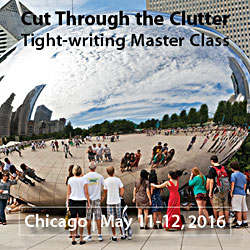People skip long paragraphs
Readers take measure of — and make decisions about — your copy based on how it looks. One of the most important visual cues is paragraph length.

If your message looks too hard to read, people won’t read it. So hit Return more often: It’s one of the easiest ways to make your message more readable.
How often should you hit Return?
We turned to The New York Times to find out how long their paragraphs are. We analyzed 99 stories in the Dec. 15, 2014, edition of The New York Times. (We skipped the sports pages.)
On this day, Times paragraphs:
- Ranged from 1.3 sentences per paragraph (“Factory Output Higher Than Expected, Adding to Optimism“) to 9 sentences per paragraph for a one-paragraph brief (“Iowa: Halal Beef Supplier Is Charged With Fraud“).
- Averaged 2.4 sentences per paragraph.
- Weighed in at a median of two sentences per paragraph.
The Times is no fluffball news outlet. Can’t you make your paragraphs as inviting as the Times?
Pare down paragraphs
Here’s the problem with long paragraphs: Readers make decisions about your message based not on what you’ve said or on how well you said it but on what it looks like after you’ve said it. And paragraph length is one of your message’s most important visual cues.
 “Long paragraphs are a visual predictor that a story won’t work,” says Jon Ziomek, associate professor at the Medill School of Journalism.
“Long paragraphs are a visual predictor that a story won’t work,” says Jon Ziomek, associate professor at the Medill School of Journalism.
But how long is too long?
At Cut Through the Clutter — our tight-writing Master Class on May 11-12 in Chicago — you’ll get proven-in-the-lab targets for paragraph length, tools for measuring your paragraphs and tips for keeping paragraphs tight and readable. Specifically, you’ll learn how to:
- Measure, monitor and manage paragraph length. What’s the average length of a print paragraph that readers are willing to read? An online paragraph? A lead?
- Punctuate with paragraphs. How to use — but not abuse — super-short paragraphs.
- Begin — and end — with a bang. How to make the most of your paragraph’s power points.
- Avoid the suitcase lead. If you stop stuffing all the W’s and H’s into the first paragraph, what goes there instead?
- Build a bridge — don’t erect a wall — at the top of your story. How to write lead paragraphs that draw readers in instead of making them flee.
If you’d like to drill down into the nitty-gritty of readability … if you’d like to learn not just what to do but how and why … if you’d like to finally convince your reviewers to stop muddying up your messages with 200-word paragraphs, this is the course for you.
Join us to learn why Kevin Trenga, manager of marketing communications for The Raymond Corp called this workshops, “The most concise, outstanding ‘short course’ on cleaning up copy.”
Save $100: Just 15 early bird tickets remain for this class. When they’re gone, they’re gone. If you’d like to secure the best price on this workshop, please register today.
Browse all upcoming Master Classes.
Would you like to hold an in-house Cut Through the Clutter workshop? Contact Ann directly.